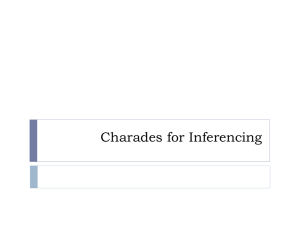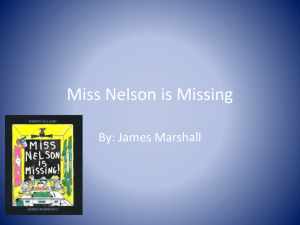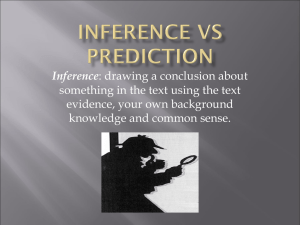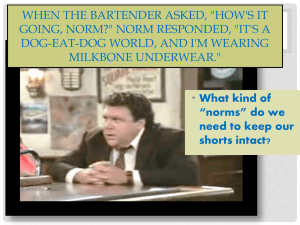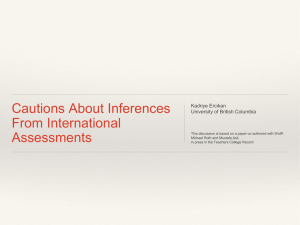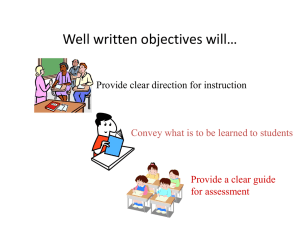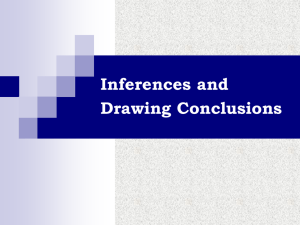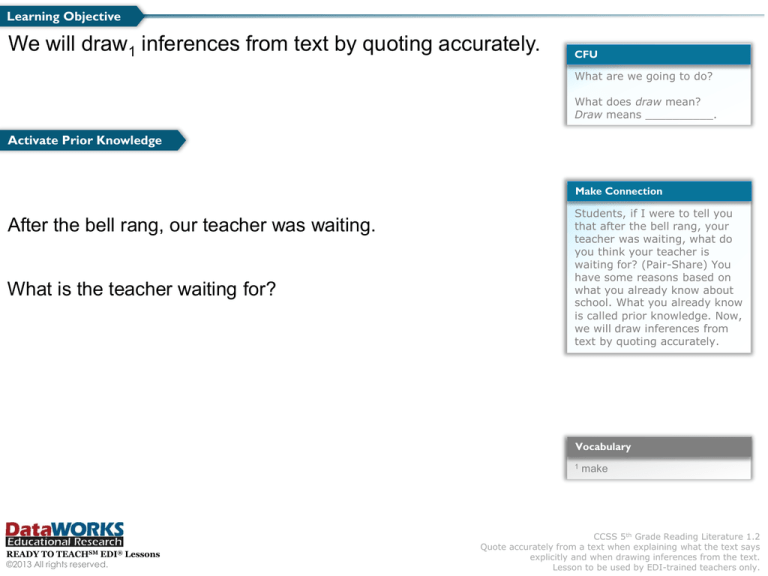
Learning Objective
We will draw1 inferences from text by quoting accurately.
CFU
What are we going to do?
What does draw mean?
Draw means __________.
Activate Prior Knowledge
Make Connection
After the bell rang, our teacher was waiting.
What is the teacher waiting for?
Students, if I were to tell you
that after the bell rang, your
teacher was waiting, what do
you think your teacher is
waiting for? (Pair-Share) You
have some reasons based on
what you already know about
school. What you already know
is called prior knowledge. Now,
we will draw inferences from
text by quoting accurately.
Vocabulary
1
READY TO TEACHSM EDI® Lessons
©2013 All rights reserved.
make
CCSS 5th Grade Reading Literature 1.2
Quote accurately from a text when explaining what the text says
explicitly and when drawing inferences from the text.
Lesson to be used by EDI-trained teachers only.
Concept Development
An inference is something that you think is true based on information that you
have.
• An inference is not directly written in the text.
• To draw an inference, we use textual evidence2 and our prior knowledge3.
To quote accurately is to repeat something correctly to support what you are
saying.
EDI Strategy
To draw an inference, we use:
+
textual
evidence
+
prior
knowledge
Draw Inferences from Text
1. Theo stood in line for three hours before the doors opened. 2. There
was a very long line of people waiting to get in. 3. As he walked inside, he
could smell popcorn and hot dogs cooking in the snack bar. 4. As the crowd
of people searched for their seats, Theo sat down and made sure his cell
phone was turned off. 5. Then the lights went out, and everyone got very
quiet.
70 words
• He could smell popcorn and hot
dogs.
• Theo made sure his cell phone
was turned off.
• Then the lights went out, and
everyone got very quiet.
Prior Knowledge
• You can buy
popcorn and hot
dogs at the movies.
• You have to turn
your cell phone off
and be very quiet.
Which statement below is
textual evidence that supports
the inference? Which is prior
knowledge? Why?
A Then the lights went out, and
everyone got very quiet.
textual evidence
What can you infer about where Theo is?
Quoting Textual Evidence
CFU
Inference
Theo is at the
movies.
B You have to be quiet at the
movies.
prior knowledge
In your own words, what is an
inference?
An inference is ____________.
Vocabulary
2
3
clues in text
(prior knowledge) what you
already know from the past
Not an example of an inference: Theo made sure his cell phone was turned off.
©2013 All rights reserved.
CCSS 5th Grade Reading Literature 1.2
Draw inferences from text.
Lesson to be used by EDI-trained teachers only.
Skill Development/Guided Practice
An inference is something that you think is true based on information that you have.
• An inference is not directly written in the text.
• To draw an inference, we use textual evidence and our prior knowledge.
To quote accurately is to repeat something correctly to support what you are saying.
CFU
1 How did I/you identify the
important words in the
question?
Draw inferences from text by quoting accurately.
1 Read the question and identify4 the words that tell you what to look for. (circle)
2 Read the text and accurately identify the textual evidence that helps you draw the inference.
(underline)
3 Explain5 the prior knowledge you have that helps you draw the inference. (write)
4 Draw an inference.
2 How did I/you identify
1. It had been pouring rain all day. 2. Suddenly, the wind started
blowing harder, the rain turned into hail, and the clouds looked as if they
were forming a funnel6. 3. We could see lightning off in the distance and
trees being tossed around in the air. 4. Before the power went out, the
National Weather Service issued a severe weather warning. 5. People
started running inside where they would be safe from falling debris7.
71 words
4 How did I/you draw an
accurately the textual
evidence that helped you
draw an inference?
3 How did I/you explain the
prior knowledge that helps
you draw an inference?
inference?
What can you infer about the weather?
My prior knowledge is:
I__________________________________________________________________
know that strong winds, hail and lightning all happen during bad storms.
Tornadoes
form into funnel clouds and can toss trees around.
__________________________________________________________________
My inference is:
__________________________________________________________________
There
is a tornado coming.
__________________________________________________________________
©2013 All rights reserved.
Vocabulary
4
find (synonym)
tell (synonym)
6 cone-shaped
7 remains of anything broken
5
CCSS 5th Grade Reading Literature 1.2
Draw inferences from text.
Lesson to be used by EDI-trained teachers only.
Skill Development/Guided Practice (continued)
An inference is something that you think is true based on information that you have.
• An inference is not directly written in the text.
• To draw an inference, we use textual evidence and our prior knowledge.
To quote accurately is to repeat something correctly to support what you are saying.
Draw inferences from text by quoting accurately.
CFU
1 How did I/you identify the
important words in the
question?
1 Read the question and identify the words that tell you what to look for. (circle)
2 Read the text and accurately identify the textual evidence that helps you draw the inference.
(underline)
3 Explain the prior knowledge you have that helps you draw the inference. (write)
4 Draw an inference.
2 How did I/you identify
1. Crystal enjoyed riding her bike through the neighborhood. 2. The only
problem was that she would throw her bike down wherever she stopped. 3. More
than once she had left her bicycle in the driveway. 4. Several times her dad
warned her not to do that. 5. One morning as her dad was leaving for work,
Crystal heard a crashing sound outside.
59 words
4 How did I/you draw an
accurately the textual
evidence that helped you
draw an inference?
3 How did I/you explain the
prior knowledge that helps
you draw an inference?
inference?
What can you infer about Crystal’s bike?
My prior knowledge is:
I know that if I leave my bike in the driveway it might get run over.
________________________________________________________________
________________________________________________________________
My inference is:
Crystal’s dad ran over her bike.
________________________________________________________________
________________________________________________________________
©2013 All rights reserved.
CCSS 5th Grade Reading Literature 1.2
Draw inferences from text.
Lesson to be used by EDI-trained teachers only.
Relevance
An inference is something that you think is true based on information that you have.
• An inference is not directly written in the text.
• To draw an inference, we use textual evidence and our prior knowledge.
To quote accurately is to repeat something correctly to support what you are saying.
1 Drawing inferences will help you “read between the lines.” Authors don’t always tell
us everything. We need to use textual evidence and prior knowledge to understand
the story better.
1. Mae’s parents moved the family here because her father could get a job. 2. Her eyes filled
with tears as she thought about the people they had left behind. 3. She didn’t know anyone here.
34 words
What can we infer about how Mae felt?
textual evidence + prior knowledge =
Mae was sad and lonely.
2 Drawing inferences will help you do well on tests.
Sample Test Question:
Read the passage below and answer the question.
Jorge was running late. He looked at his watch. He was getting
ready for school when suddenly he heard the bus coming
around the corner. Jorge ran out of the house and towards the
bus stop.
3. What can you infer about Jorge?
A
B
C
D
©2013 All rights reserved.
He was not in a hurry.
He wanted to watch the bus drive by.
He was worried that he might miss the bus.
He was not going to school that day.
CFU
Does anyone else have another
reason why it is relevant to
draw inferences about text?
(Pair-Share) Why is it relevant
to draw inferences about text?
You may give me one of my
reasons or one of your own.
Which reason is more relevant
to you? Why?
CCSS 5th Grade Reading Literature 1.2
Draw inferences from text.
Lesson to be used by EDI-trained teachers only.
An inference is something that you think is true based on information that you have.
• An inference is not directly written in the text.
• To draw an inference, we use textual evidence and our prior knowledge.
To quote accurately is to repeat something correctly to support what you are saying.
Skill Closure
Draw inferences from text by quoting accurately.
1
2
3
4
Word Bank
inference
textual evidence
prior knowledge
quote accurately
Read the question and identify the words that tell you what to look for. (circle)
Read the text and accurately identify the textual evidence that helps you draw the inference. (underline)
Explain the prior knowledge you have that helps you draw the inference. (write)
Draw an inference.
1. There were lots of fresh fruits and vegetables being sold on the side of the road. 2. The days were
longer and the air felt very hot. 3. People were getting their pools and water toys ready to use. 4. As for
the children, they were looking forward to the end of another school year.
52 words
What can we infer about the season?
My prior knowledge is:
I know that school ends in June. In June, the days are very hot.
_______________________________________________________________________________________
My inference is:
The
season is summer.
________________________________________________________________________________________
Access Common Core
From the passage above, why is “The air felt very hot” not an example of an
inference? Explain your answer.
Summary Closure
What did you learn today about drawing inferences from text by quoting accurately? (Pair-Share)
Use words from the word bank
©2013 All rights reserved.
CCSS 5th Grade Reading Literature 1.2
Draw inferences from text.
Lesson to be used by EDI-trained teachers only.
Independent Practice
An inference is something that you think is true based on information that you have.
• An inference is not directly written in the text.
• To draw an inference, we use textual evidence and our prior knowledge.
To quote accurately is to repeat something correctly to support what you are saying.
Draw inferences from text by quoting accurately.
1 Read the question and identify the words that tell you what to look for. (circle)
2 Read the text and accurately identify the textual evidence that helps you draw the inference.
(underline)
3 Explain the prior knowledge you have that helps you draw the inference. (write)
4 Draw an inference.
1. It has been a long day. 2. Joe and Phil wipe the sweat from their foreheads.
3. Joe put away the rake and shovel. 4. Phil turned off the lawn mower. 5. They
looked at the huge bags of leaves and grass sitting in the driveway. 6. Joe and Phil
couldn’t wait to show their dad all their hard work!
55 words
What can you infer about the type of work Joe and Phil did all day?
My prior knowledge is:
________________________________________________________________
I know that a rake and shovel can be used to clean up leaves and dirt.
________________________________________________________________
A lawn mower is used to cut grass.
My inference is:
Joe and Phil did yard work all day.
________________________________________________________________
________________________________________________________________
©2013 All rights reserved.
CCSS 5th Grade Reading Literature 1.2
Draw inferences from text.
Lesson to be used by EDI-trained teachers only.
Independent Practice (continued)
An inference is something that you think is true based on information that you have.
• An inference is not directly written in the text.
• To draw an inference, we use textual evidence and our prior knowledge.
To quote accurately is to repeat something correctly to support what you are saying.
Draw inferences from text by quoting accurately.
1 Read the question and identify the words that tell you what to look for. (circle)
2 Read the text and accurately identify the textual evidence that helps you draw the inference.
(underline)
3 Explain the prior knowledge you have that helps you draw the inference. (write)
4 Draw an inference.
1. After a few hours, we arrived at our destination. 2. I set up my tent, roasted1 a marshmallow,
and sat with my family around the warm campfire. 3. The park ranger stopped by our campsite to tell us to pack
up all of our food before we went to sleep because animals often walk through the campsites at night. 4. We
finally decided to go to bed. 5. I had just drifted off to sleep, when I was startled2 by a growling noise just
outside my tent. 6. I wanted to see what it was, but I was too scared to unzip my tent!
99 words
What can you infer about what is growling outside the tent?
My prior knowledge is:
I’ve been camping, and the ranger told us bears walk around the campground at night.
_________________________________________________________________________________________
I also know bears growl.
_________________________________________________________________________________________
My inference is:
A bear is outside the tent.
_________________________________________________________________________________________
Vocabulary
1
2
©2013 All rights reserved.
cooked over fire
scared (synonym)
CCSS 5th Grade Reading Literature 1.2
Draw inferences from text.
Lesson to be used by EDI-trained teachers only.
Periodic Review 1
1. Carol was really excited about her brother coming home on Sunday night. 2. However, by the
time Sunday came around she had already had a very busy weekend. 3. Saturday, she went with her
family on a trip to the lake after being out Friday night at a party. 4. Carol also helped a friend paint
her bedroom Sunday afternoon. 5. When Carol came home from her friend’s house, she plopped
down on the couch. 6. Next thing she knew, her brother was home.
79 words
What can you infer about Carol’s weekend?
My prior knowledge is:
When I do a lot of things during the weekend, I get very tired.
______________________________________________________
______________________________________________________
My inference is:
Carol was so tired that she fell asleep before her brother got
______________________________________________________
home.
______________________________________________________
Access Common Core
1. Jerrica and Annabell were partners for their school science project. 2. They still had to complete
the last of the data collection portion of the project. 3. Jerrica called Annabell on Wednesday after school
and told her she would be available to work on their project after dinner. 4. That evening, Annabell rode
her bike over to Jerrica's house. 5. When Annabell arrived she rang the bell. 6. Disappointed, Annabell
got back on her bike and went home.
73 words
Sophie inferred that the passage above is about Jerrica and Annabell working together that evening on
their project.
Is she correct?
Use prior knowledge and textual evidence to explain your answer.
©2013 All rights reserved.
CCSS 5th Grade Reading Literature 1.2
Draw inferences from text.
Lesson to be used by EDI-trained teachers only.
Periodic Review 2
1. When the alarm sounds, our teacher tells us to stop what we are doing, leave everything, and
push in our chairs. 2. We line up at the door in a single file line. 3. Our teacher leads us out into the
hallway where we have to stand in a line and wait. 4. Then our teacher does a head count to make
sure everyone is there. 5. We walk out to the field in a line. 6. I can see all of the other students in our
school walking in lines just like ours. 7. When we get out onto the grass, our teacher tells us to stop.
105 words
What can you infer about what is happening at the school?
My prior knowledge is:
When an alarm goes off, it means that there is something
______________________________________________________
wrong and that we need to get out of the building.
______________________________________________________
My inference is:
It was a fire drill.
______________________________________________________
______________________________________________________
Access Common Core
Read the passage and explain how Nicole made her inference.
1. The full moon shown bright on the sleepy little town of Garrick. 2. However, this was no ordinary
night for the people of Garrick. 3. It was on the night of a full moon that the creature would roam the area
terrorizing everyone. 4. The people stayed inside their homes hoping the creature, would pass them by
except for one soul named Nikos. 5. He was tired of being afraid of this creature and he planned on
doing something about it. 6. Armed with his sword, he quietly waited. 7. Suddenly, the creature came out
of the brush and everything went black for Nikos. 8. Next thing he knew, the people of Garrick were
cheering and thanking him for what he had done.
117 words
Nicole’s Inference: Nikos killed the creature.
©2013 All rights reserved.
CCSS 5th Grade Reading Literature 1.2
Draw inferences from text.
Lesson to be used by EDI-trained teachers only.
Periodic Review 3
1. Rachel is not in a good mood. 2. Her head feels like a balloon, she can’t stop shivering, and she can barely
breathe. 3. No matter how much Rachel blows her nose, she can’t clear it enough to take in a good breath of air. 4. To
make matters worse, Rachel’s mother has dragged her out of her warm bed to an awful place filled with miserable 1
people. 5. Everywhere around, Rachel hears people sneezing and coughing. 6. She glances at the clock and sees that
they have already been waiting for forty minutes. 7. Just as Rachel is about to complain to her mom again, a lady in red
scrubs2 calls her name. 8. Rachel’s mother gets up to follow the nurse, and Rachel gloomily trails behind.
125 words
What can you infer about what is wrong with Rachel and where she is?
My prior knowledge is:
______________________________________________________
I know that when I have a cold it is hard to breathe and that I
______________________________________________________
sneeze a lot. I also don’t want to go anywhere.
My inference is:
______________________________________________________
Rachel has a cold and her mom took her to the doctor.
______________________________________________________
Access Common Core
1. Suddenly the door burst open and something else came in. 2. It was like a hairy, short-necked camel
with a head like a giant hyena3. 3. It was so big that its shoulders stuck out the top of the door. 4. Students
screamed, jumped, ran, and fell in a wild scramble to get away. 5. The door frame was torn out as the beast
pushed into the room. 6. Sidway and Eubee recovered first and started shooting spells at the beast as it shook
free of the door and looked all around the room.
89 words
excerpt from Normality is the Exception by Chris Malloy
Joseph and Camilla both drew inferences about the passage above.
Joseph’s inference is that the students were in a wizard’s class.
Camilla’s inference is that the students were in a normal class.
Vocabulary
1
extremely unhappy
clothes that nurses wear
3 wild, violent dog-like animal
2
Who do you think is correct?
Use prior knowledge and textual evidence to explain your answer.
©2013 All rights reserved.
CCSS 5th Grade Reading Literature 1.2
Draw inferences from text.
Lesson to be used by EDI-trained teachers only.

